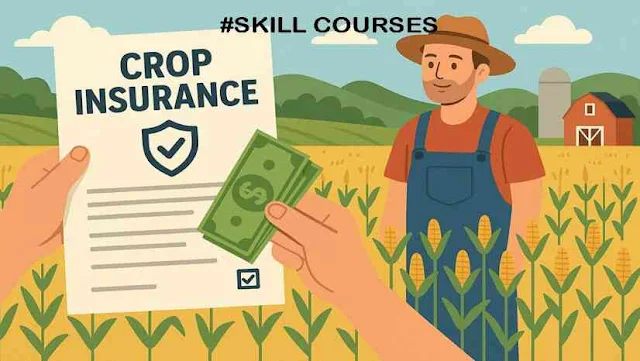Introduction
- Agriculture is the backbone of many economies, especially in India. However, it is highly dependent on weather and other natural conditions. To protect farmers from potential losses due to uncertain events like drought, floods, or pest attacks, crop insurance is crucial.
What is Crop Insurance?
- Crop insurance is a risk management tool that provides farmers with financial compensation for crop losses or damages due to unforeseen natural or man-made events.
Importance of Crop Insurance
- Protects farmers from income loss
- Encourages investment in quality inputs
- Reduces dependence on informal credit
- Ensures food security
Types of Crop Insurance
- Yield-based Insurance: Covers shortfall in yield compared to average historical yield.
- Weather-based Insurance: Covers crop loss due to deviations in weather conditions like rainfall, temperature, humidity, etc.
Key Features of Crop Insurance
- Affordable premiums
- Wide range of crop coverage
- Coverage against natural disasters
- Compensation for crop failure
Government Crop Insurance Schemes
- Pradhan Mantri Fasal Bima Yojana (PMFBY)
- Launched in 2016
- Farmers pay 2% for Kharif, 1.5% for Rabi, and 5% for commercial crops
- Rest is subsidized by the government
Eligibility Criteria for Farmers
- Should be an Indian citizen
- Must cultivate an insurable crop
- Should have insurable interest in the land
- Both landowners and tenant farmers are eligible
How to Apply for Crop Insurance
Offline:
- Visit nearest agriculture office or Common Service Center (CSC)
Online:
- Use official portals like https://pmfby.gov.in
- Register with Aadhaar number and land details
Documents Required
- Aadhaar Card
- Land ownership proof or lease document
- Crop sowing certificate
- Bank account details
- Passport-size photo
Premium Calculation
Example:
| Crop Type | Season | Premium Rate | Sum Insured | Farmer’s Share |
|---|---|---|---|---|
| Paddy | Kharif | 2% | ₹30,000/acre | ₹600/acre |
| Wheat | Rabi | 1.5% | ₹25,000/acre | ₹375/acre |
Sum Insured and Coverage
The sum insured is the maximum amount the farmer can receive in case of total crop loss. It depends on:
- Crop type
- Expected yield
- Historical yield data
- Market price
Risks Covered
- Drought
- Flood
- Cyclone
- Hailstorm
- Pests and diseases
- Lightning
- Landslide
Risks Not Covered
- War, nuclear risks
- Intentional damage
- Theft or damage after harvesting
- Poor farm management
Claim Process
Steps:
- Notify insurer or agriculture officer within 72 hours
- Submit damage report
- Field inspection by insurance company
- Claim settlement within 30 days
Role of Weather and Natural Disasters
- Since most crops depend heavily on rainfall and temperature, weather-index insurance plays a vital role. Weather stations record data to calculate payout eligibility.
Crop Insurance Companies in India
- Agriculture Insurance Company of India
- ICICI Lombard
- HDFC Ergo
- Bajaj Allianz
- Reliance General Insurance
Case Study: A Farmer’s Story
- Ramesh, a farmer in Maharashtra, insured his soybean crop under PMFBY. Due to heavy rains, he lost almost 80% of his crop. He filed a claim online, and within a month, he received ₹20,000 as compensation. This helped him repay his loan and prepare for the next season.
Benefits of Crop Insurance
- Financial stability
- Encourages adoption of modern techniques
- Reduces farmer suicides
- Promotes sustainable farming
Challenges in Crop Insurance
- Low awareness
- Delay in claim settlement
- Poor infrastructure
- Weather station data inaccuracy
Technological Role in Crop Insurance
- Satellite imagery for crop assessment
- Drone-based field inspections
- AI and Big Data for risk modeling
Mobile Apps and Online Portals
- PMFBY App: For scheme details and claim status
- Kisan Suvidha App: Weather info and crop advisory
- Crop Insurance App by Ministry of Agriculture
Awareness Among Farmers
- Awareness campaigns by government and NGOs are helping farmers understand the importance of crop insurance through:
- Village meetings
- Radio and TV ads
- Mobile messages
Tips for Farmers
- Insure crops every season
- Keep all documents ready
- Report damages promptly
- Check eligibility and premium details
- Use government websites and apps
Future of Crop Insurance
- Expansion to more crops
- Better integration with technology
- Faster claim settlement
- Inclusion of post-harvest losses
Conclusion
Crop insurance is a lifeline for farmers. It helps reduce uncertainty, improve income stability, and encourages investment in agriculture. While there are challenges, efforts are being made to make the system more efficient, transparent, and farmer-friendly
Also Read:















0 Comments